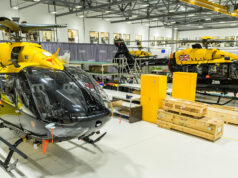The U.S. Joint Counter-Small Unmanned Aircraft Systems Office (JCO) has successfully tested BAE Systems’ APKWS laser-guidance kits in a counter-unmanned aircraft systems (C-UAS) mission.
The test, conducted against Class-2 UAS according to BAE, “opens the door for the precision-guided rockets to be fielded to partner nations worldwide”.
BAE say here that APKWS technology “transforms unguided rockets into smart munitions for accurate strikes on soft and lightly armoured targets”.
A newly developed proximity fuze for the standard M151 warhead enables the laser-guidance kits to target Class 2 and Class 3 drones, which typically weigh less than 55 pounds.
During the U.S. Department of Defense-led exercise at Yuma Proving Ground, Arizona, the 70mm APKWS-guided rockets “demonstrated 100% effectiveness” when fired against 25 to 50-pound drones traveling at over 100 miles per hour.
Aimee D’Onofrio, a director of Precision Guidance and Sensing Solutions at BAE Systems, was quoted here by the firm as saying:
“Our engineers’ passion for APKWS technology led to the development of this new product designed to meet drones head-on. This is a solution that comes at a remarkably affordable price point, and with APKWS already at full-rate production, we can ramp up to 25,000 units per year to make an immediate impact.”












There’s a definite question about what is the cost effectiveness/benefit of using an APKWS versus a proximity fused shell, especially when fired at a class 2 or smaller drone?
The price difference between the two favors the proximity shell. As for ground use the APKWS will have a comparable effective range to a 40mm shell (BAe 3P for example).
Nammo, of 155mm ramjet powered shell fame. Have been contracted to explore designing a new rocket motor for the APKWS (Hydra 70). With the requirement to increase the range and terminal velocity. Which could push the range past 3km when fired from the ground.
The big issue is still with the detection of these small drones. A number of higher frequency radars can detect them. But because of the low speed, which is less than 50knits in most cases. Which makes them hard to tell apart from birds. So a lot of them get filtered out.
The answer maybe linking a X/Ku-band radar with a much higher frequency radar. Which could then be used to capture an image of the target. Which would then aid target recognition. The only issue with this, is that a W-band radar has a very short range due to atmospheric attenuation. Unless you want to significantly ramp up the output power. The lower power output is fine for a target closer than 5km however.
Or is it really about having options and being able to upgrade racks that already exist on platforms in service?
If it is an existing munition then clearing a new targeting system is much quicker than clearing a new munition.
Equally while the 3P is great it need a trainable barrel to fire it out of which may not be on the platform?
Certainly the Ukrainians are having great success with taking out drones with aircraft and other air assets, which can cover far wider areas and be zeroed in if the attacking drones are detected rather than just hoping they fly near enough to an available gun platform that probably has other priorities and locations away from their attack vectors too. The fact that these kits can be land launched too gives an extra option, but their usefulness on helicopters, fixed wing or even drones where they can have a 12km or so range gives them so much more potential value in the scenarios that Ukraine is experiencing. They would love this option I bet and would likely equal any other use they are using those assets for. At $22,000 they are a lot cheaper than using conventional missiles against drones too, which they are presently forced to do. Widely available too.
Out of interest, ignoring other plus/minus aspects, I wonder on average how many proximity fused artillery shells you would expend on average to bring down a drone, assuming they are around $500 or so per shot, presuming it would take generally speaking one of these to do the same job. Anyone have an insight. Flexibility in potential defensive measures is probably the ideal here whatever the answer.
Also maybe simpler/cheaper to mass produce too?
You don’t need Mach3 to take down a drone!
I would imagine a simple single/double base propellant motor would suffice for a short range, anti-drone rocket.
The same munition is used to kill Cruise missiles as well…and you do need speed then.
The Rheinmetall/Oerlikon Skyshield using the 35mm gun fires on average 7 shots for a hit at 1.5km. The 35mm shells use time fuzing only, so must rely on the base tracking radar for the time settings. The BAe/Bofors 40mm using 3P shells can on average get a hit with the third round at a similar 1.5km.
In both cases it is dependent on the range to the target. As the weapon system must work out not only the range to the target but its predicted location of where to aim to make the intercept. So a lot will depend on the sensor accuracy and how quickly the fire control system can work out a firing solution. Bearing in mind most data manufacturers publicly show, is from a benign trial, where the target is flying straight and level. But in any case, the 3P shell with the proximity fuze has the distinct advantage over a timed fuze.
The third option being the guided shell, such as BAe’s OKRA, L3 Harris Alamo and Raytheon’s MAD-FIRES. Where the expectations is one shot one kill. Though the cost of the more complicated MAD-FIRES is going to be comparable to the APKWS.
I wonder if 3 shells would really hit a drone in practice. Surely the human part of the control chain would notice 2 other shells exploding near by the drone and adjust the course making all the previous calculations based on the previous 2 redundant. Guided really is the only realistic option against anything in the air, as found out in ww2.
It kind of depends on whether the drone’s camera and operator sees that the gun is pointing at it. Otherwise it won’t know its being targeted, until shells start going off in close proximity.
Much like the US Reaper that was hit by the Su27. It didn’t know they were there until one of the Su27s did a close flyby. At which point the operator started scanning the sky as they always fly as a pair. As far as I’m aware Reaper does not have a radar warning system fitted, though this may change after the event over the Black Sea.
Drones don’t usually start flying erratically, for starters depending on how its being controlled i.e. by satellite datalink. There can be over a second time delay between commands. Which could be enough time for a triple A system to get a bead on the drone and bang off a few rounds.
I think with surveillance drones in particular keeping the cost low is really important. There is too much of a risk with Gold Plating the system. Which means you can’t afford a large number of systems and crucially it means you will soon loose capability if they are shot down eg Watchkeeper. Ukraine’s use of the TB2 is the right direction. Where it is relatively cheap and uses surveillance systems that are good enough.
I agree that a guided shell is far more preferable than say a time delayed shell. However, cost will come into play. Which is why the US Navy are investing in the ALAMO shell along with the more expensive and capable MAD-FIRES. From what I understand its radio command guided, requiring the ships CMS to steer it towards the target. It also uses what are called pop-out bolts that disrupts the airflow allowing it to steer.
This is a very simple method of creating a guided munition. It won’t for instance be able to keep up with a target that is manoeuvring erratically. As every time it steers, its creating a lot of drag, which then slows it down. But against something like a speed boat or a small drone it will be useful, as it also incorporates a proximity fuze. Just a pity that CTAS in Ajax is 40mm and not 57mm, then it could have been used by Ajax after a bit of fettling. Or even MAD-FIRES from a telescoping cartridge, hmm, now that would be interesting!
Rheinmetall worked out that a single Cheetah missile was cheaper than a couple of bursts of 35mm AHEAD ammunition (their equivalent of 3P).
People forget how expensive modern programmable ammunition like 3P and AHEAD actually cost.
Not convinced about kinetic kills of small lower end drones. These drones will always have a cost advantage over the solution to kill them, the airframe and electronics do not need to be as sophisticated as the high end projectile that needs to intercept them. Direct energy has to be the way forward.
I agree, small toy-like UAVs will always have the advantage of a guided weapon, when it comes down to cost. Therefore, the laser is probably the most effective bang per buck as a solution.
Dragonfire has already shown it can take out a number of different sized drones at distance. Scaling it down so that the power supply etc can be carried in a Boxer, must be the next goal. DARPA have demonstrated a counter-UAS fitted to a Stryker. Though the laser’s power output wasn’t that great. So the capability is coming, just not quickly enough for my liking.
There has been some recent chatter between Nexter and BAe, in regards to the use of 3P ammo in the CTAS 40mm gun. At present the anti-air ammo uses timed fuzing. But feedback from Ukriane has shown how much ammo is being expended taking out drones. There has also been talk in using Ajax in an anti-drone role. However, I don’t believe it will have a sensor appropriate for searching for very small drones.
Hi Davey, the sensors on AJAX would be visual/optical only, however the Primary sight can auto track targets so I wonder if this could be used against drones?
I know Ajax has the latest generation thermal imager. So it should have no issues tracking an object. But finding it in the first place Ajax could do with some help. It’s a pity Ajax couldn’t be fitted with Starstreak’s ADAD from the Stormer. Which would then give it a passive 360 degree view and search capability of air threats. Plus its pretty good at spotting ground targets. Mind you ADAD needs updating as it is a couple of decades old now.
Hi Davey, the Primary sight is able to point in the direction of a target cued by the acoustic detection system (small arms, cannon, aircraft / UAS? etc) as can the turret. Also, as the PS is panoramic, it can conduct an automatic sweep of a designated area, again alerting the crew to areas / objects of interest. I think that may cover UAS?
The ADAD sensor was, through a round about route, developed into the Asraam seeker….
Interestingly we’ve just developed an entirely new seeker for Asraam Block VI….all UK IP as well.
ADAD is perfect for IFV’s and anti-UAV/Loitering Munitions….no emissions either.
Part of that was to de ITAR as much exportable stuff as possible.
I wonder if the US understands the long term damage ITAR is causing to defence exports?
It is creeping now abut gathering momentum.
This is the bit I don’t get. The Apache has the rocket pods and they couldnt be used in Iraq/afgan because they were too inaccurate, which surely translates into outdated and useless (modern warfare is about accuracy rather than saturation as numbers aren’t there for it). Even just for their primary job of anti armor warfare why didn’t the MOD invest in these. Plus surely way cheaper to fire one of these at a pickup truck/drone than a hellfire.
APKWS is the laser guidance retrofit for 70mm rockets, not the unguided rockets in pods you refer to.
They can be launced from pods or from ground vehicles.
I thought they were the guided addon that is added to the end of the existing rockets and can be used on the existing pods. Effectively turning the unguided pod into semi guided munition
This is a new version of the rocket that has just been tested?
The UK Apache are US spec so will be compatible with these?
Nothing appears to have been lost in this?
2 points….
We didn’t deploy Apache to Iraq, US did and fired 10’s of thousands of rockets…
We did deploy Apache to Afghanistan….and we also fired thousands of CRV7…it was a standard loadout…
Interesting, I thought the gov blocked the use of the rocket pods due to collateral damage risk, the same reason they didn’t deploy chally.
HE, Flechette and MPSM (carrying 9 M73 submunitions) were all used in Afghan. Literally thousands of them..
Why tell Putin.?
If you have the time the latest issue of European Security and Defence is online and well worth a butchers. I can recommend the chapters on Anti tank weapons and 155mm SPGs
That’s a great title, really informative. I’m going to be downloading that every month from now onwards. Cheers Farouk
The MOD has just spent £4.6 million on an rrder for the Charlie G
Martlet would be good at this for the more high value drones?
O/T possible AAC news
https://www.janes.com/defence-news/defence/latest/uk-eyes-wildcats-for-manned-surveillance-role
Youtube videos seem to show Stormer/Starstreak/LMM combo in Ukrainian service, shooting down Russian drones. As a result, the Russians have targetted/struck, two of these Stormer fire units.
Hopefully more than two have been sent and the two destroyed replaced.
Are these APKWS’ on the UK’s Apache’s?
Could be good on the Wildcats too?
The South Koreans have put Spike NLOS on their Wildcats.
And I read that Greece rececently ordered them for their Apache’s. Not sure what the Australian Apache’s will have. Hope the UK is getting the longest ranged AGMs possible and not just going for the cheap and easy.
We have not yet ordered APKWS, rumours the AAC are interested.
The ideal would be APKWS guidance sections mated to our existing CRV7 rockets rather than having to purchase the far inferior Hydra 70 rockets that the US uses.
But…given the morons have ordered JAGM rather than Brimstone I wouldn’t hold out any hope….
Isn’t 8km effective range for JAGM? That’s absolute crap of true! Surely triple plus that is needed, like 25-50km?
*if
It was more about getting a large army program done, dusted in time and on budget.
So basically no whistles or Gucci bells allowed. No fiddling.
Any mods have to be made after ISD.